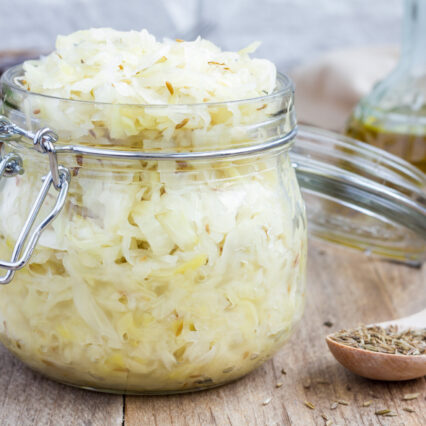6 Veggies (and Recipes) for Optimal Gut Health
Photos: Getty Images
“Although all veggies are good for you, some pack an outsized punch when it comes to promoting gut health. These six vegetables, and the easy recipes that go with them, will help your inner garden grow.”
It seems unlikely that our digestive tracts would be a major intersection of body and mind—but recent research has shown that they are.
The makeup of the microbiome in your gut—all the bacterial flora in your digestive tract—turns out to be a major player in overall health. And when we say health, we mean everything, from cognition and emotional wellbeing to cardiovascular fitness and the prevention or reduction of chronic disease.(See more benefits in “7 Reasons You Need Prebiotics.”)
It’s thought that your body’s microbiome is largely established in the first thousand days of life. But because this system gets so much input every day from you—and because different bacteria thrive on different types of food—there’s a lot you can do to affect your gut health through what you put on your plate. Studies have found that the “bad” bacteria that cause the harmful inflammation that leads to a host of bodily ills tend to thrive on processed, fried, or refined foods, while eating whole, unprocessed ingredients feeds the “good” microbiota—the bacteria that protect your body and keep inflammation down.
Although all veggies are good for you, some pack an outsized punch when it comes to promoting gut health. These six vegetables, and the easy recipes that go with them, will help your inner garden grow.
Onions
Onions, the invisible vegetable, can seem like they’re in everything—but that’s a plus when it comes to gut health. As part of the allium family, this nutrient-dense vegetable is particularly rich in prebiotics, or fiber that’s indigestible to humans but a rich food source for benefitical gut bacteria. This pissaladière recipe puts onions front and center, to glorious effect.
Leafy Greens
When clean eating is the topic, dark leafy greens like spinach, kale, and chard tend to get lumped together—but there’s a reason for that. Together, they’re a powerhouse class of vegetables that are not only packed with nutrients and prebiotics, but have also been shown to contain a type of sugar, sulfoquinovose, that protective bacteria thrive on. Step outside your regular recipe rotation with this India-inspired recipe that blends collard greens, apricots and cumin.
Garlic
Garlic is another allium that not only has a big flavor profile, but a potent effect on health. Not only does it have antioxidant and antimicrobial properties, but research has found that a compound in garlic, allyl sulfide, feeds gut bacteria that have the ability to counteract declines in cognitive health and memory. When I’m feeling the need for a big dose of garlic, I make the easy French classic, chicken with 40 cloves of garlic.
Jicama
Jicama, an edible root vegetable that’s native to Central America, looms large in Mexican cuisine. It also packs a whopping 10g of the prebiotic inulin into every 100g serving. (Compare that with asparagus, often cited as a good source of inulin, which only contains 2-3 g per 100 g serving). Once considered a specialty product, jicama is now available in many grocery stores—and even better, it’s commonly eaten raw, for its savory, crispy crunch. The less a vegetable is cooked, the better it tends to be for gut health. Try it in this piquant jicama appetizer.
Artichokes
Another exceptionally rich source of prebiotics, artichokes have been shown to increase bifidobacteria, a class of bacteria that make up less than 10% of an adult microbiome but are crucial to gut health. Bifidobacteria use inulin as a food source, and produce the short-chain fatty acids that protect against disease, regulate the immune system, and even control obesity by sending signals of satiety. Nothing beats artichokes prepared simply.
Burdock
Burdock is one of those potent vegetables that straddles the border between food and medicine. Traditional cultures in both the old and new worlds used this low-calorie, inulin-rich root as both. As a food, burdock is versatile. It comes in a sweet, mild-tasting flour substitute that makes for prebiotic cookies, and it can also be prepared the Japanese way, for a delicious, easy side dish that’s also high in nutrition.
Want more? Check out our story on “10 Ways to Support a Healthy Microbiome.”

There’s one notable exception to the idea that processed foods = less gut health. Fermenting vegetables in certain ways supercharges their ability to enrich your microbiome. Not only do they provide prebiotic fiber, they also provide the friendly probiotics that can seed your gut with good bacteria. For a powerful gut health boost, two fermented veggies from opposite sides of the planet are sauerkraut, which is traditionally eaten with German meats but can also punch up avocado toast, and kimchi, a Korean flavor enhancer used in dozens of easy ways. My go-to is this delicious fried rice recipe that swaps out white rice for healthy, prebiotic-rich brown rice.


